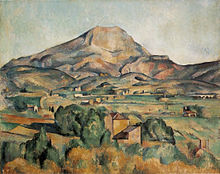| Mont Sainte-Victoire seen from Bellevue | |
|---|---|
 | |
| Artist | Paul Cézanne |
| Year | c. 1895 |
| Medium | Oil on canvas |
| Movement | Post Impressionism |
| Dimensions | 73 cm × 92 cm (29 in × 36 in) |
| Location | Barnes Foundation, Pennsylvania |
Mont Sainte-Victoire seen from Bellevue is a landscape painting dating from around 1886, by the French artist Paul Cézanne. The subject of the painting is the Montagne Sainte-Victoire in Provence in southern France. Cézanne spent a lot of time in Aix-en-Provence at the time, and developed a special relationship with the landscape. This particular mountain, that stood out in the surrounding landscape, he could see from his house, and he painted it in on numerous occasions. [1]
Moreover, Cézanne depicted the railway bridge on the Aix-Marseille line at the Arc River Valley in the center on the right side of this picture. [2]
The painting shows clearly Cézanne's project of rendering order and clarity to natural scenes, without giving up the optical realism of Impressionism. [3] Both the light and the colours of the painting give the impression of a pattern that is not imposed on nature, but is there naturally. [3]
See also
References
- ^ Becks-Malorny, p. 67.
- ^ "Cézanne and the Steam Railway (3): His Railway Subjects in Aix-en-Provence". Tomoki Akimaru (Art Historian). Retrieved November 10, 2022.
- ^ a b Gombrich, pp. 538-41.
Sources
- Becks-Malorny, Ulrike Paul Cézanne, 1839-1906: Pioneer of Modernism (Cologne, 2001), ISBN 3-8228-5642-8
- Gombrich, E.H., The Story of Art, 16th ed. (London & New York, 1995), ISBN 0-7148-3355-X
- Tomoki Akimaru, "Cézanne and the Steam Railway (1)~(7)", (Japan, 2012).
| Mont Sainte-Victoire seen from Bellevue | |
|---|---|
 | |
| Artist | Paul Cézanne |
| Year | c. 1895 |
| Medium | Oil on canvas |
| Movement | Post Impressionism |
| Dimensions | 73 cm × 92 cm (29 in × 36 in) |
| Location | Barnes Foundation, Pennsylvania |
Mont Sainte-Victoire seen from Bellevue is a landscape painting dating from around 1886, by the French artist Paul Cézanne. The subject of the painting is the Montagne Sainte-Victoire in Provence in southern France. Cézanne spent a lot of time in Aix-en-Provence at the time, and developed a special relationship with the landscape. This particular mountain, that stood out in the surrounding landscape, he could see from his house, and he painted it in on numerous occasions. [1]
Moreover, Cézanne depicted the railway bridge on the Aix-Marseille line at the Arc River Valley in the center on the right side of this picture. [2]
The painting shows clearly Cézanne's project of rendering order and clarity to natural scenes, without giving up the optical realism of Impressionism. [3] Both the light and the colours of the painting give the impression of a pattern that is not imposed on nature, but is there naturally. [3]
See also
References
- ^ Becks-Malorny, p. 67.
- ^ "Cézanne and the Steam Railway (3): His Railway Subjects in Aix-en-Provence". Tomoki Akimaru (Art Historian). Retrieved November 10, 2022.
- ^ a b Gombrich, pp. 538-41.
Sources
- Becks-Malorny, Ulrike Paul Cézanne, 1839-1906: Pioneer of Modernism (Cologne, 2001), ISBN 3-8228-5642-8
- Gombrich, E.H., The Story of Art, 16th ed. (London & New York, 1995), ISBN 0-7148-3355-X
- Tomoki Akimaru, "Cézanne and the Steam Railway (1)~(7)", (Japan, 2012).
